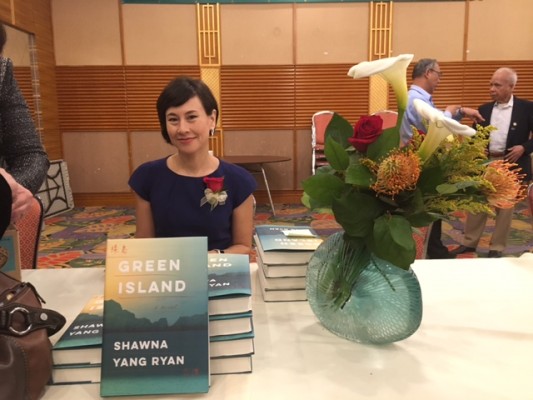Today is February 28 or 228, one of the darkest days in Taiwanese history. In 1947, a widow selling cigarettes on the sidewalk was accosted by tax agents for not having the right permits (sound familiar?) which was the proverbial straw that broke the camel’s back that was already tense with resentment of the Taiwanese against the Chinese Nationalists who had been given control over the island after World War II. The protests that followed sparked a massacre of Taiwanese leaders, intellectuals and anyone who might have supported independence from the Chiang Kai-Shek’s Kuomingtang regime.
Green Island by Shawna Yang Ryan (Amazon affiliate link) opens the evening the unrest begins. A doctor’s wife is going into labor with her fourth baby, but the happy event is overshadowed when the doctor must tend to a dying victim of police brutality. And so begins the era of White Terror for Taiwan. The doctor who treats the gravely injured protester is taken away in the middle of the night. His daughter, the baby born that night, becomes the voice of the novel whose timeline roughly mirrors the run of martial law in Taiwan from 1947 through the 1980s.
Like Ryan’s first novel, Water Ghosts, Green Island is rich with historical detail. As she told a banquet hall full of mostly first-generation Taiwanese Americans in Cupertino yesterday, Ryan received a Fulbright Scholarship to do research in Taiwan for three years, visiting historic sites and doing extensive interviews with 228 survivors and their families to gather information about what it was like to have fathers and uncles disappear in the night when police came knocking at their doors. While Ryan described the conditions in the Green Island jails for political prisoners, one woman old enough to have witnessed 228 as a child held her face in her hands. Upon returning to the United States, she continued to research events such as the murder of San Francisco journalist Henry Liu, which was widely ascribed to KMT hit men. The title, Green Island, comes from a song of the same name that some people believe was a revolutionary anthem written by a prisoner disguised as a long song.
Green Island not only captures the history of Taiwan but paints a portrait of the generation that lived through this part of Taiwanese history. As a second-generation Taiwanese American who grew up hearing tidbits about the massacre and warnings to not talk too publicly about Taiwanese autonomy, it feels very true to the atmosphere of my youth. There are also some nuanced sub themes involving the relationships between islanders and mainlanders and also between Taiwanese women and American GIs. In fact, Ryan, whose mother is Chinese-Taiwanese and father was a white American airman, says she wanted to create nuanced portrayals of those interracial romances.
While the history is thick, ultimately it’s a compelling story of love, family and self-reckoning that also happens to illuminate this part of history for many American readers who have no doubt never heard of any of these events. There have been a few novels in recent years set during or reflecting back on this chapter of Taiwanese history, such as The Third Son by Julie Wu or The 228 Legacy (affiliate links)
by Jennifer J. Chow, and it seems that we are at the tip of a Taiwanese American literary movement, with the urgency of memorializing these experiences as the post World War II generation of Taiwanese advances in age.



[…] with the beautifully haunting artwork, the accompanying texts are written by writers including Shawna Yang Ryan, Maya Soetoro-Ng, Konrad Ng, and Matthew Salesses. Particularly interesting to parents is a segment […]